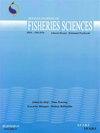Optimum weight of stellate sturgeon (Acipenser stellatus) fingerling to release into brackish water: plasma electrolytes, plasma hormones and histological observation
IF 0.6
4区 农林科学
Q3 FISHERIES
引用次数: 1
Abstract
The present study was conducted to determine the appropriate weight to release the hatchery produced fingerling of stellate sturgeon, Acipenser stellatus, into its natural habitat. For this purpose, prolactin and cortisol hormones, plasma electrolytes and osmolality as well as histological changes in the gill and kidney of stellate sturgeon transferred from fresh to brackish water at different weight (0.5, 1, 2, and 3 g) were assessed during a one-week time course. A total of 2400 fingerlings with different weights (0.5, 1, 2, and 3 g) were equally assigned into 24 aquariums, each one containing 200 L of freshwater or brackish water. After 24 hours, prolactin showed the highest concentration in 0.5 and 3 g fish groups kept in both experimental waters. Cortisol exhibited a time-dependent increase in the 0.5 g group in both experimental waters as well as the 2 g larvae kept in the brackish water. Generally, lower levels of Mg2+, Ca+2; K+, Na+, and Cl- were measured in the fish kept in freshwater aquariums. The lowest levels of osmolarity were found in the 0.5 g fingerling, especially those kept in the freshwater aquariums, whereas the highest levels were observed in 3 g groups in both experimental waters. Histological assessments illustrated that the volume of chloride cells in freshwater increased with increasing fish weight, whereas the cell count decreased. The same held true for glomerular capillary network size. Taken together, the evidence from this study suggests that stellate sturgeon fingerling less than 2 g are almost incapable to be transferred to brackish and saline environment, due to lack of kidney and gill development.星形鲟鱼种入咸淡水中最佳放生重量:血浆电解质、血浆激素及组织学观察
本研究旨在确定将孵化场生产的星状鲟鱼种(星状鲟)放归其自然栖息地的适当重量。为此,在一周的时间过程中,评估了不同重量(0.5、1、2和3克)从淡水转移到半咸水的星状鲟鱼的催乳素和皮质醇激素、血浆电解质和渗透压以及鳃和肾的组织学变化。共有2400只不同重量(0.5、1、2和3克)的鱼种被平均分配到24个水族馆,每个水族馆含有200升淡水或半咸水。24小时后,在0.5和3g的鱼组中,泌乳素的浓度最高。0.5g组在实验水中和2g幼虫在微咸水中的皮质醇都表现出随时间的增加。一般来说,Mg2+、Ca+2含量较低;测定了淡水养殖鱼类的K+、Na+和Cl-含量。在0.5克的鱼种中发现渗透压水平最低,尤其是那些饲养在淡水水族馆中的鱼种,而在两种实验水中,3克组的渗透压水平最高。组织学评估表明,淡水中氯细胞的体积随着鱼类体重的增加而增加,而细胞数量则减少。肾小球毛细血管网大小也是如此。总之,这项研究的证据表明,由于缺乏肾脏和鳃的发育,小于2克的星状鲟鱼鱼种几乎无法转移到半咸水和盐水环境中。
本文章由计算机程序翻译,如有差异,请以英文原文为准。
求助全文
约1分钟内获得全文
求助全文
来源期刊

Iranian Journal of Fisheries Sciences
FISHERIES-
CiteScore
2.30
自引率
11.10%
发文量
0
审稿时长
3 months
期刊介绍:
1- Living various species (contains animals and vegetal species) in various aquatic ecosystems.
2- Health and diseases of aquatic species.
3- Determining the stocks and specific time and location for catching and reliable exploitation for sustainable development.
4- Methods of propagation and culture of high value aquatic resources.
5- Aquatic stock assessment and the methods of restocking the high value species and suggestion for rate, areas and the time for releasing fish and other aquatic organisms fries.
6- Pollutant agents and their effects to the environments of aquatic species.
7- Feed and feeding in aquatic organisms.
8- Fish processing and producing new products.
9- The economic and social aspects of fisheries.
 求助内容:
求助内容: 应助结果提醒方式:
应助结果提醒方式:


